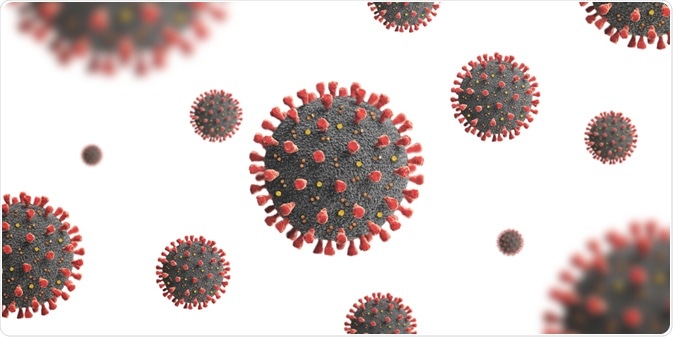Loop-mediated isothermal amplification, or LAMP, is an assay that can be used for viral RNA detection. Reverse-transcription LAMP (RT-LAMP) allows for quicker analysis of genetic material than traditional PCR and has been successfully used in the detection of the COVID-19 virus.

Image Credit: https://www.frontiersin.org/articles/10.3389/fmicb.2016.02166/full
How does RT-LAMP work?
The methodology for RT-LAMP was based on the mechanism behind auto cycling strand displacement DNA synthesis. A polymerase carries out the reaction, and the polymerase has high strand displacement activity. There are also two pairs of primers used; one pair of inner and one of the outer primers. These primers are specially designed for the reaction.
RT-LAMP can achieve high specificity due to the target sequences. Unlike other technologies, RT-LAMP recognizes the target sequence using six independent sequences at the start and by four independent sequences towards the latter stages.
Primer recognition of the target genome leads to a strong colorimetric reaction, which allows for detection without highly specialized or costly instrumentation. Similar methods rely on the turbidity of the sample, which increases with the amount of genetic material, to measure viral content. Amplification and detection can also be done by agarose gel analysis.
Uses and benefits of RT-LAMP
While relatively new technology, invented in 2000, there are several examples where it has been used. An assay specifically for the hepatitis B virus has been successfully developed and used. This is also true for the West Nile virus, where specificity was high to the West Nile virus and not other members of the Flavivirus group.
The benefits of RT-LAMP are important for the viability of broadscale use of this technology. Chief among these is that amplification of genetic material is done quickly under isothermal conditions, which removes the requirements for a thermal cycler.
This also allows for higher amplification efficiency, because there is no need to wait for thermal changes, and thus no time is lost. Whereas a traditional PCR can take around 3 to 4 hours, RT-LAMP takes less than an hour.
Other benefits include the high specificity and selectivity for the genetic material in question. Some experiments have found RT-LAMP to be 10 times more sensitive than normal RT-PCR assays. RT-LAMP also has higher specificity, with no false-positive results reported.

Image Credit: Stanisic Vladimir/Shutterstock.com
COVID-19 and RT-LAMP technology
RT-LAMP is the perfect technology for use in the COVID-19 pandemic due to its accuracy and relatively simple equipment. This means tests can be carried out in non-standard institutions, such as airports or rural hospitals or medical centers.
A primer set to be used for detecting the SARS-CoV-2 virus using RT-LAMP has been developed. This assay can detect the virus even with low sample concentrations. The sample preparation for this can be carried out in just one tube within minutes. Furthermore, only three buggers, a pulse-spin mini-centrifuge, and a 65°C heat block are needed to apply this method at institutions.
The primers designed for this target several key areas of coronavirus genomes, including the ORF1ab gene, S gene, and N gene. ORF1ab is involved in the replication of the viral genome, whereas the S gene is important for COVID-19 binding to human ACE2 protein. The N gene is a nucleocapsid protein conserved in most coronaviruses.
A key improvement in the COVID-19 LAMP assay is the speed and ease at which it can be carried out. Combining a standard LAMP assay with reverse transcription (thus making it RT-LAMP) is possible by commercially available reverse transcriptase, which shortens the reaction time to 20 minutes.
Furthermore, the color change associated with the presence of viral RNA, at levels as low as 80 copies per ml sample, is visible by eye, and therefore detection equipment is not needed. This was achieved by using a pH indicator. Amplification of nucleic acids causes the release of pyrophosphate and hydrogen ions, which lead to decreases in pH, therefore making it possible to combine RT-LAMP with a visible pH indicator to infer the presence of COVID-19.
Despite this, there are some limitations to applying RT-LAMP in its current form. When testing the COVID-19 RT-LAMP method, cross-contamination was common. The authors believe this was due to the formation of aerosols from the RT-LAMP products. This would require the separation of the RT-LAMP reaction. Despite this, all 16 samples used in the study were correctly identified as positive or negative, which was verified by RT-qPCR.
Sources
- Zimmerman, G., 2020. Rapid Point-Of-Care COVID-19 Detection Assay By RT-LAMP. [online] Harvard Office of Technology Development. Available at: <https://otd.harvard.edu/explore-innovation/technologies/rapid-point-of-care-covid-19-detection-assay-by-rt-lamp>.
- Parida, M., Posadas, G., Inoue, S., Hasebe, F., and Morita, K., 2004. Real-Time Reverse Transcription Loop-Mediated Isothermal Amplification for Rapid Detection of West Nile Virus. Journal of Clinical Microbiology, 42(1), pp. 257-263.
- Huang, W., Lim, B., Hsu, C., Xiong, D., Wu, W., Yu, Y., Jia, H., Wang, Y., Zeng, Y., Ji, M., Chang, H., Zhang, X., Wang, H. and Cui, Z., 2020. RT‐LAMP for rapid diagnosis of coronavirus SARS‐CoV‐2. Microbial Biotechnology, 13(4), pp. 950-961.
Further Reading
- All Coronavirus Disease COVID-19 Content
- What Mutations of SARS-CoV-2 are Causing Concern?
- What is the Clinical Impact of COVID-19 on Cancer Patients?
- Can Pets Get COVID-19?
- An Overview of the SARS-CoV-2 Vaccines
Last Updated: Jul 22, 2020

Written by
Sara Ryding
Sara is a passionate life sciences writer who specializes in zoology and ornithology. She is currently completing a Ph.D. at Deakin University in Australia which focuses on how the beaks of birds change with global warming.
Source: Read Full Article
